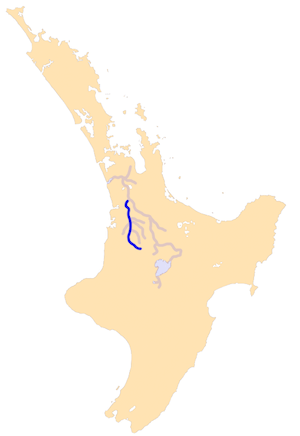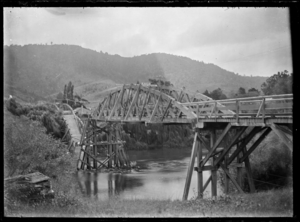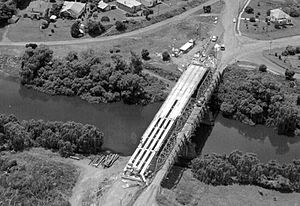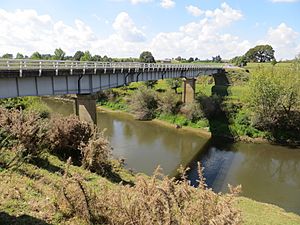Waipa River facts for kids
Quick facts for kids Waipa River |
|
|---|---|

From Waingaro Rd bridge looking north down Waipa River to Ngāruawāhia Point bandstand, the Waikato (coming from right) and the Hakarimata Range in the background (19-9-2012)
|
|

The Waipa River – The Waikato's largest tributary
|
|
| Country | New Zealand |
| Physical characteristics | |
| Main source | Rangitoto Range 703 m (2,306 ft) |
| River mouth | Waikato River 20 m (66 ft) |
| Length | 115 km (71 mi) |
| Basin features | |
| Basin size | 3,050 km2 (1,180 sq mi) |
| Tributaries |
|
The Waipa River is in the Waikato region of the North Island of New Zealand. The headwaters are in the Rangitoto Range east of Te Kuiti. It flows north for 115 kilometres (71 mi), passing through Otorohanga and Pirongia, before flowing into the Waikato River at Ngāruawāhia. It is the Waikato's largest tributary. The Waipa's main tributary is the Puniu River.
In the headwaters upstream of Otorohanga the river can be very clear during low flow conditions. This section of the river flows through rough farmland and patches of native bush. In this clearer part of the river there can be very good fly fishing for trout but access to the river may be limited without landowner permission.
The Waipa is prone to flooding in its lower reaches as flood flows can be over 100 times—20 to 560 m3/s (710 to 19,780 cu ft/s)—those of dry flows and the river can rise up to 11 m (36 ft).
In 2013 Maniapoto Māori Trust Board and the riparian local councils set up a joint management agreement for the river, following the passing of Nga Wai o Maniapoto (Waipa River) Act 2012.
Contents
Speed of flow

The table below shows the time water takes to flow the 130 km (81 mi) from Te Kuiti to its confluence with the Waikato in times of low flow (15% of days are slower than this) and high flow (15% of days faster) -
| time (hrs) | |||
|---|---|---|---|
| Place | km | low | high |
| Te Kuiti | 0 | 0 | 0 |
| Otorohanga | 37 | 20 | 13 |
| Pirongia | 73 | 40 | 25 |
| Whatawhata | 101 | 59 | 36 |
| Ngāruawāhia | 130 | 98 | 49 |
Power stations
In 2003 Hydro Power Ltd was given consent to build a hydro-electric power station, with weirs in the Okahukura Stream, upstream from Owen Falls, and penstocks carrying water down the gorge to a station on the west bank 2.5 kilometres (1.6 mi) below the falls. Work was done in 2006, but, in 2007, Hydro Energy (Waipa) Ltd was fined for unconsented damage to native vegetation in building the penstock. The resource was initially estimated to be able to generate 10 to 20MW. Construction halted, though Renewable Power bought the asset in 2010 and estimates potential at 9MW.
In 2017 Nova Energy were given consent to build a 360MW gas-turbine station (connected to the Maui Gas Pipeline) on the Ongaruhe Stream, close to its confluence with the Waipa. The mid-merit Waikato Power Plant at 869 Kawhia Rd, Otorohanga is expected to be used for 10 to 15 minutes, 3 or 4 times a day.
Pollution
Waikato Regional Council measures water quality monthly at five sites from Mangaokewa to Whatawhata. The measurements show poor quality along most of the river, with excess nitrogen, silt and phosphorus, though E. coli levels have improved with improved sewage treatment, though generally not enough for safe swimming; recreational rivers should have median E. coli levels below 126 per 100ml, but Waipa's range from 160 to 320. Turbidity levels north of Otorohanga rise to more than double the levels needed to support plant photosynthesis and phosphorus levels also rise above targets in that stretch. Nitrogen levels increased at all five sites between 1993 and 2012 due to intensified land use, now adding 3,075 tonnes a year. By comparison, the total from sewage works and Te Awamutu dairy factory is 66 tonnes.
Ministry for the Environment figures averaged between 1998 and 2007 showed the Waipa at Otorohanga had 280 E.coli per 100ml (53rd worst out of 154), 360 faecal coliforms per 100ml (83rd of 252), 0.55 mg/litre nitrogen (161th of 342) and 0.03 mg/litre phosphorus (187th of 361).
At Pirongia the figures were 390 E.coli per 100ml (35th worst out of 154), 425 faecal coliforms per 100ml (64th of 252), 0.49 mg/litre nitrogen (174th of 342) and 0.06 mg/litre phosphorus (80th of 361).
At Whatawhata the figures were 0.92 mg/litre nitrogen (94th of 342) and 0.06 mg/litre phosphorus (69th of 361).
In the Mangaokewa stream 0.02 mg/litre phosphorus (237th of 361).
Pollution has been worsening for nitrogen and phosphorus, though turbidity has improved, as shown in this table of important (ie slope direction probability over 95% and RSKSE over ±1% pa) improvements, or deteriorations (-) in relative seasonal Kendall slope estimator (RSKSE) trends (% per year). in the river at Whatawhata (monthly records are flow-adjusted using a Lowess curve fit with 30% span.) -
| Turbidity | Nitrate-N | Dissolved reactive P | |
|---|---|---|---|
| 1993–2017 | 2.0 | -1.2 | |
| 2008–2017 | 5.9 | -2.0 |
Soil conservation
Regional Council estimates that 8,718 ha (21,540 acres) is at risk of severe erosion in the Middle Waipa (Waitomo, Turitea, Pirongia, Karakariki, Puniu, Mangaotama, Mangawhero and Mangapiko catchments) and 350 km (220 mi) of stream bank to be prone to erosion. Project Watershed plans for planting on 1,594 ha (3,940 acres), plus 976 km of stream bank and 1,332 km of fencing, from 2017 to 2026.
Organic farming
In 2018 a scheme was launched by the Waikato River Authority to attract investment in $100 million of hybrid bonds to convert up to 18 dairy farms on 6,539 ha (16,160 acres), or roughly 5% of the catchment, to organic farms, with the aim of reducing pollution from the worst farms by about 45%.
Bridges
Listed in order from the confluence with the Waikato and moving south they are:-
- 1898 Ngāruawāhia bridge opened. Collapsed under a herd of cattle 20 December 1916 (see 1917 photo) and rebuilt in 1922 with three 110 ft (34 m) trusses. The bridges were preceded by a punt (see 1922 photo), supplied by the government in 1887. A new bridge was opened on 18 January 1974.
- 1914-1958 Waipa Railway and Coal Co. 21 metres (70 ft) long bridge.
- 1881 (20 April) Whatawhata bridge, originally wooden and 160 m (520 ft) long and 15 ft (4.6 m) above high water mark, consisted of two spans of 24 m (80 ft), 7 of 40 and 4 of 6.1 m (20 ft), and cost £3700. Repairs were done in 1909, but it was in poor repair again by 1917. For £11,250 a new truss bridge was built over the top of it in 1924. The current SH23 concrete bridge, which is south of the original site, was shown on the 1974 edition of the 1 inch Lands & Survey map, but not on the 1965 3rd edition. Records of the road structure show it dates from 1971, which is probably the date of the bridge. The bridge replaced a punt, which had operated from 1867.
- 1881 (12 August) 120-metre (400 ft) long Te Rore bridge. Replaced 1957. In the 1958 flood, only the handrails were visible.
- 1865 (about) Alexandra Bridge, Baffin St, Pirongia, originally built by the army. Pukehoua Bridge was built 600 m (660 yd) upstream in 1912–13 to replace the 1865 bridge, which was damaged by floods and by 1909 was only fit for pedestrians and light traffic. Public Works Department estimated its cost at £4,500, £1,500 coming from Government and £3,000 from Waipa (50%), Raglan (30%) and Waitomo (20%) councils.
- 1882 Alexandra Bridge, McClure St, Whatiwhatihoe, Pirongia."Mr. Wright has superintended the construction of the Alexandra Bridge, over the Waipa River, to give access to Tāwhiao's new settlement, Whatiwhatihoe (see map), and which will at the same time eventually be on the main line leading into the King country. The bridge will be open now in a fortnights' time, it consists of six 7.3 m (24 ft) spans, and three 12 m (40 ft) trusses, a total length of 80 m (264 ft), the height being 13 m (42 ft) above ordinary river level. The approaches and about a mile of road, and a large culvert have been made by Mr. Wright, with Maori labor. The whole will have been completed at a cost of about £1,800." There was a plan to replace it in 1939. SH39 now crosses on a 112.8-metre-long (370 ft) 1953 bridge.
- 1915 Te Kawa Rd bridge 100 metres (340 ft) long, 12 metres (40 ft) high.
- Kawhia Rd, Ōtorohanga, SH31/SH39 cross on a 147.5-metre-long (484 ft) 1964 bridge.
- Maniapoto St, Otorohanga photo about 1910 SH3 now crosses on a 51.8-metre-long (170 ft) 1964 bridge. It replaced a bridge built in the early 1950s.
- 1887 North Island Main Trunk railway bridge.
- 1928 Toa Bridge, Otewa Rd.
Steamer services
Over 50 kilometres (31 mi) was navigable by waka and Pirongia (Alexandra) was busy as the head of steamboat navigation until the railway was built to Te Awamutu in 1880, though some settlers used it as far as Te Kuiti, though possibly only as far as the confluence of the Mangapu and Mangaokewa streams, about 4 mi (6.4 km) upstream from Ōtorohanga. Mr Gibbons' steamship, Lillie, started in 1876 to 1878. From 1902 to 1909 H H Gould ran the 1899 5 hp SS Opuatia from Ngāruawāhia to Whatawhata one day and on to Pirongia next day. A 1915 guidebook still said, "Small steamers ply up and down the river from Huntly". An 1881 article said a journey upriver would normally take 36 hours, but more in dry weather, when shoals at Whatawhata and Te Rore were hard to cross. An 1898 petition complained about wharfage charges at Mercer being a tax on residents along the Waipa. Around 1900 the Freetrader, owned by the Waikato Company, "was withdrawn owing to competition from the Walsh brothers with their launch Victory, which could traverse the winding Waipa much more easily than the cumbersome stern-wheeler."
As late as 1919 Waipa County Council pressed for removal of shingle shoals to permit navigation to Pirongia and got money for improvements from government and the county councils. Evidence given to the Inland Waterways Commission in 1921 said boats carrying 20 tons could reach Pirongia for most of the year and, up to about 30 years before, vessels carried 60 tons to Pirongia and a special fleet of steamers ran to Te Kuiti. Steamers were set back by the sinking of the Opuatia at Whatawhata in 1920. The Waikato Shipping Co had been running a weekly service to Pirongia with the former Waihou River steamer, SS Erin (and sometimes SS Excelsior), which seems to have continued until WSC stopped trading in 1922. A Public Works Department report in 1925 said the river was non-navigable above its junction with the Mangapu at Otorohanga.




